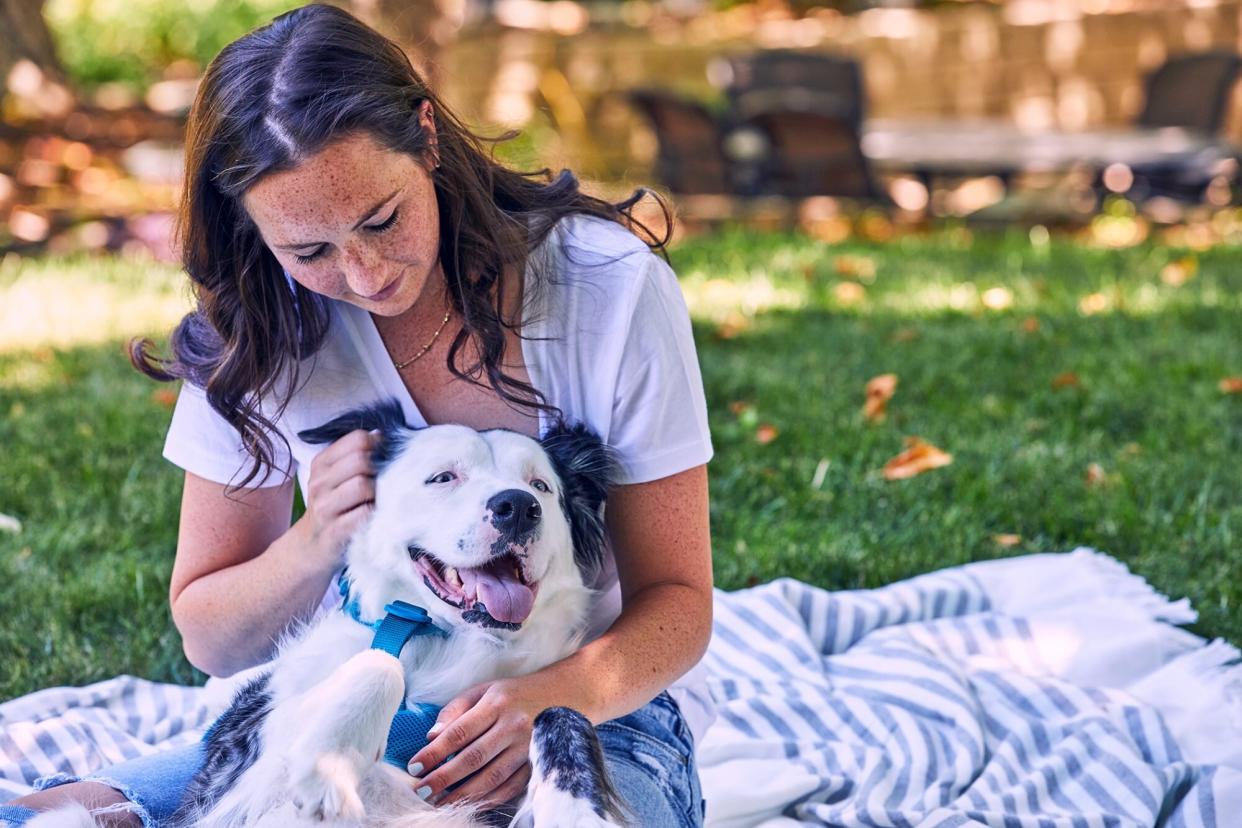Why Do Some Dogs Like to Cuddle—and Others Don't? A Behavior Expert Explains

Jason Donnelly
TABLE OF CONTENTS
On This Page
Why Do Dogs Cuddle?
Why Dogs Don't Like to Cuddle
Are Some Dogs More Cuddly?
Other Ways to Bond
You're snuggled on the couch, relaxing and streaming your favorite show, and who's curled up right next to you with their head on your lap? None other than your favorite canine companion. But have you ever wondered why some dogs like to cuddle ... but others don't? Here are some possible reasons.
Why Do Dogs Cuddle?
One primary reason why some dogs like to cuddle is because they consider you part of their close-knit group and want to show affection and love, says Zac Pilossoph, DVM, CMFT, CAVM.
Pilossoph likens dog cuddling to canines meeting at the dog park. First, they smell one another to get a feel for their new friend and generate a memory of them. If they like each other, they cuddle and rub up against each other to show their fondness and friendship.
But there's another important reason why pups seek out close contact. Kristyn Echterling-Savage, PhD, CAAB, BCBA-D, is a certified applied animal behaviorist and behavior analyst, as well as founder and CEO of Beyond the Dog training centers. She says aside from showing affection, some dogs try to cuddle—or appear to—when they're exhibiting fear.
"Dogs afraid of thunderstorms, fireworks, or other loud or scary environmental events might try to cuddle," she explains. "Knowing the difference is essential, because providing too much attention when dogs engage in a fear-related response can make the behavior worse longterm."
Why Do Dogs Not Like to Cuddle?
Echterling-Savage says every dog has a different way of showing affection, which could be dependent on their breed or genetic makeup, or because of early life experiences. Some puppers may only want to cuddle based on temperature, which might change dramatically whether they're overly cold or hot.
We also need to consider that the ways we physically demonstrate love aren't often preferred by them. For example, many dogs don't like kisses, hugs, or tickles. Some don't even like their bellies rubbed!
RELATED: The Expert Guide on How to Properly Pet a Dog
But here's the good news: By paying close attention to your dog's body language, you'll pick up on all sorts of signals about if and how your dog likes to cuddle.
"Just like us, dogs want and need physical contact. For many, sitting or sleeping near their owner is a way to cuddle," Echterling-Savage says. "Others invite cuddles or pets by rolling over, vocalizing in a specific way, or approaching with a wiggly body."
Whether or not your pet gets snuggly, Echterling-Savage says that teaching dogs to be physically handled using classical conditioning is essential. "This is important in life for grooming and veterinary procedures. Through classical conditioning, those touches are paired with pleasant things, mainly treats!" Early socialization helps, too.
Do Some Dogs Cuddle More Than Others?
While always keeping in mind that each pooch has an individual personality, anecdotal evidence suggests some dogs are more cuddly than others. Echterling-Savage says if you're wondering about a specific breed, check their history first.
"I generally view toy breeds as lap dogs, but breeds outside of this group are big cuddlers, too. Most bully breeds tend to be, such as the American Staffordshire terrier, American bulldog, American pit bull terrier, and bull terriers, to name a few," she says. "Bird dogs, too, including the German shorthaired pointer, Vizsla, and Weimaraner. Be careful, though—these hunting dogs tend to develop separation anxiety."
And even some largest dog breeds, such as Great Danes or mastiffs, can be snugglers, too. "I believe some giant breeds get the stereotype of being lap dogs because they sometimes like to 'sit' on your lap," Echterling-Savage says. "They don't know just how giant they are!"
However, Pilossoph cautions prospective pet parents not to choose a breed based on a canine's natural predilection to cuddle, as a dog's preferences can change over time for various reasons, including unexpected health issues or behavioral problems.
Other Ways to Bond Besides Cuddling
It's perfectly fine if your pooch doesn't want to cuddle. You've probably noticed many other ways he thinks you're awesome, such as during playtime, traveling together, or even waiting patiently for you to return home.
"I think it's important to note that, while cuddling is fun and relaxing with our dogs, many other activities are essential for our bond and their physical, emotional, and social wellbeing," Echterling-Savage says.
If you haven't had a chance to try the following methods for bonding with your dog, they're fun, easy—and often free!
Do more of your pet's favorite activities. It's hard to imagine, but not all dogs enjoy playing fetch. Maybe they'd rather dive into an interactive toy, laze in the sun, or take a sniff walk (or "sniffari"). As long as you're engaged with them or even just nearby, the two of you are bonding.
Train them to do something new. Positive reinforcement training continually strengthens the bond between you by building trust and improving communication. It's helpful for your canine friend to understand basic skills and behavior cues, and different tricks make life together more interesting.
If you'd like additional bonding or training tips, arrange for sessions with a certified animal behavior expert.

